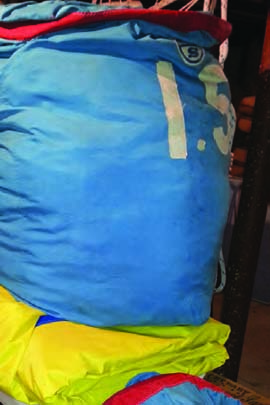
Remove ‘em – The first step to ensuring that your sails are ready to be washed, dried, folded and stowed for the winter is the remove them (all of them) from your boat. You may not have used a particular sail during the season, but doesn’t mean it shouldn’t be checked at season’s end. Moisture, critters and other nasties can still invade an unused sail.
Wash – For best results, bring your sails to a sailmaker for a professional cleaning. If you want to do the job yourself, soak the sails with a hose to remove salt, and use soap and a scrub brush to remove dirt. Rinse them and let them air dry thoroughly before rolling them up.
Inspect stitching – If you find any missing, broken or faded stitches, bring the sail to your sailmaker for repair…and don’t until spring to do it. Your sailmaker will appreciate the off-season work, and your sail(s) will be ready to go at launch time.
Batten pockets – Worn or chafed batten pockets must be repaired, and make sure the battens fit properly and don’t have rough edges or sharp corners.
Mainsail slides – Replace any broken luff slides, as well as any white plastic ones that have turned yellow from age and exposure to sunlight.
Genoa luff tape – If the ends of your luff tape are frayed, trim the bad areas away with shears and finish the new edges with a hot knife.
Look for chafe – Inspect the spreader patches on both sides of your genoa for scratches or scoring, as well as any areas where sails come into contact with shrouds, lifelines, etc.
Check old repairs – Sails that are heavily used throughout the season may have had a tear, scrape or hole that was either repaired on board or fixed at a loft. These repairs should be examined to ensure that the patch or stitch has held up over time.
Store them properly – Put your sails in a warm, dry place, and be absolutely certain that insects and rodents won’t be able to get to them. Mice will nest in sails and they will ruin them.



